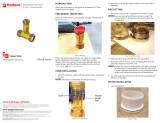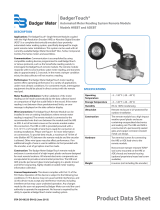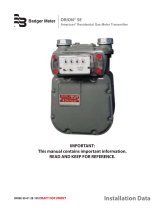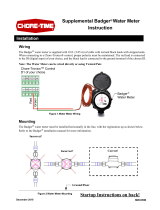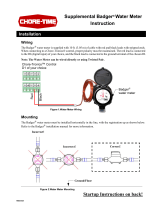Page is loading ...

Flow Meters
Model COIN®
User Manual
DPM-UM-00519-EN-04 (March 2016)

Flow Meters, Model COIN®
Page ii March 2016DPM-UM-00519-EN-04

CONTENTS
Introduction. . . . . . . . . . . . . . . . . . . . . . . . . . . . . . . . . . . . . . . . . . . . . . . . . . . . . . . . . . . . . . . . . . . . . . . . . 5
Scope of Manual . . . . . . . . . . . . . . . . . . . . . . . . . . . . . . . . . . . . . . . . . . . . . . . . . . . . . . . . . . . . . . . . . . . 5
Safety Information . . . . . . . . . . . . . . . . . . . . . . . . . . . . . . . . . . . . . . . . . . . . . . . . . . . . . . . . . . . . . . . . . . 5
Unpacking and Inspection. . . . . . . . . . . . . . . . . . . . . . . . . . . . . . . . . . . . . . . . . . . . . . . . . . . . . . . . . . . . . 5
Straight Pipe Run Requirements . . . . . . . . . . . . . . . . . . . . . . . . . . . . . . . . . . . . . . . . . . . . . . . . . . . . . . . . . . . . 6
Selecting a Mounting Location. . . . . . . . . . . . . . . . . . . . . . . . . . . . . . . . . . . . . . . . . . . . . . . . . . . . . . . . . . . . . 7
Line Installation . . . . . . . . . . . . . . . . . . . . . . . . . . . . . . . . . . . . . . . . . . . . . . . . . . . . . . . . . . . . . . . . . . . . . 10
Dierential Pressure Connections . . . . . . . . . . . . . . . . . . . . . . . . . . . . . . . . . . . . . . . . . . . . . . . . . . . . . . . . . . 10
Typical Pressure Port Congurations . . . . . . . . . . . . . . . . . . . . . . . . . . . . . . . . . . . . . . . . . . . . . . . . . . . . . 11
User Manual
Page iii March 2016 DPM-UM-00519-EN-04

Flow Meters, Model COIN®
Page iv March 2016DPM-UM-00519-EN-04

INTRODUCTION
The Preso COIN® flow meter accommodates most flows, even the most abrasive. Accuracy and reliability are achieved by its
rugged construction, practical design and simple principle of operation. It stands alone in its ability to maintain the necessary
square root relationship between flow rate and differential pressure for almost any type of flow. Even viscosities up to 3,000
centipoise do not affect the accuracy of the meter. The flow coefficient stays highly predictable down to the remarkably low
Reynolds number of 300. This makes the meter ideal for traditionally difficult-to-meter applications such as fuel oil, waste
water, coal tar, iron ores, black liquor and others.
Scope of Manual
This manual is includes installation instructions for the Preso COIN flow meter to help you get the meter up and
running quickly.
Safety Information
The installation of the COIN flow meter must comply with all applicable federal, state, and local rules, regulations, and codes.
Failure to read and follow these instructions can lead to misapplication or misuse of the COIN flow meter, resulting in personal
injury and damage to equipment.
Unpacking and Inspection
Upon opening the shipping container, visually inspect the product and applicable accessories for any physical damage such
as scratches, loose or broken parts, or any other sign of damage that may have occurred during shipment.
OTE:N If damage is found, request an inspection by the carrier’s agent within 48 hours of delivery and file a claim with the
carrier. A claim for equipment damage in transit is the sole responsibility of the purchaser.
Introduction
Page 5 March 2016 DPM-UM-00519-EN-04

STRAIGHT PIPE RUN REQUIREMENTS
Proper operation and performance is dependent on the required lengths of unrestricted upstream and downstream piping.
The minimum length of the upstream side of the COIN Flow Element depends on the type of fitting at the start of the straight
run, and the pipe configuration. See Figure 1. The minimum lengths will cause a slight coefficient shift.
Figure 1: Piping requirements
1. For upstream and downstream lengths equal to one half the values shown above, add 1 percent to the accuracy value.
2. Any ow conditioner shall be installed in the straight length between the primary element and the upstream distance, or
the tting closest to the element. The straight lengths between tting and conditioner shall be at least 10D and the length
between conditioner and COIN meter shall be at least 15D.
3. For other ttings or congurations, contact the factory.
Straight Pipe Run Requirements
Page 6 March 2016DPM-UM-00519-EN-04

SELECTING A MOUNTING LOCATION
Install COIN elements horizontally, rotated 90° along the pipe center line, see Figure 2. This method of mounting allows for free
passage of solids and eliminates air entrapment at the transmitter connection. Other positions are acceptable provided there
is proper venting of the transmitter and differences in lead line elevations are considered. Vertical installations as shown in
Figure 3 may introduce a slight hydrostatic head effect, which must be considered when zeroing the transmitter. Connections
between the COIN meter and the transmitter should be 3/8 in. (9.53 mm) tubing minimum. Use a three-valve manifold for
zeroing the transmitter.
COINMETER
3-VALVE
MANIFOLD
TRANSMITTER
*
CAUTION
Hd
Figure 2: COIN meter with flanged taps Figure 3: Vertical installation
Each flow element has an arrow indicating the required direction of flow. Failure to properly orient the COIN element may
cause improper results when using data supplied for an element that has been calibrated.
NOTES:
1. Φ =1 in./ft (80 mm/m) for water;
2...4 in./ft (60...320 mm/m for more viscous uids.
2. Minimize all lead line lengths.
Figure 4: Typical horizontal installation for liquid
Selecting a Mounting Location
Page 7 March 2016 DPM-UM-00519-EN-04

NOTES:
1. Φ =1 in./ft (80 mm/m) for water
2. Minimize all lead line lengths.
Figure 5: Typical horizontal installation for gas
Figure 6: Typical horizontal installation for steam
Selecting a Mounting Location
Page 8 March 2016DPM-UM-00519-EN-04

Figure 7: Typical vertical installation for liquid
Figure 8: Typical vertical installation for gas
Selecting a Mounting Location
Page 9 March 2016 DPM-UM-00519-EN-04

Figure 9: Typical vertical installation for steam
NEVER EXCEED THE MAXIMUM PRESSURE OR TEMPERATURE RECOMMENDED FOR THE MEASURED PROCESS.
EXCEEDING PROPER PRESSURE OR TEMPERATURE RATINGS CAN LEAD TO PERSONAL INJURY OR EQUIPMENT DAMAGE.
THE PROCESS PIPING FLANGES SHOULD BE IDENTICAL TO THOSE ON THE COIN METER. THE PROCESS TEMPERATURE
AND PRESSURE SHOULD NEVER EXCEED THAT FOR WHICH THE ELEMENT WAS DESIGNED.
Selecting a Mounting Location
Page 10 March 2016DPM-UM-00519-EN-04

LINE INSTALLATION
All flanged COIN flow elements require a gasket between the process line connection and the mating flange. Make sure the
gaskets selected match the the size and rating of the COIN meter and the line flanges. Gasket material must be selected to
resist corrosive attack of the process.
Be sure that the gaskets are properly centered so that protrusion into the pipe opening is minimized before completing
the bolting process. Misalignment may cause added flow turbulence, however performance affects are typically minimal
depending upon the application. Bolt the element in line with suitable hardware using recommended bolt torques for the
type and class rating of the flanges.
Torque all models per ANSI flange ratings.
Tighten the flange bolts in a progressive “star” pattern to avoid localized stresses on the gaskets.
MPORTANTI
Do not exceed the specified torque.
DIFFERENTIAL PRESSURE CONNECTIONS
The high pressure connection is always on the upstream side of the flow direction arrow and the Iow pressure connection
on the downstream side. Fittings used must be able to withstand the process temperature and pressure conditions as well as
provide proper corrosion resistance. Badger Meter offers three types of fittings, see “Typical Pressure Port Configurations” on
page 12. See to the appropriate transmitter manual for connections to the transmitter high and Iow ports.
When installing chemical tee seals, tighten cap screws uniformly in a “star” pattern to avoid localized stresses on the gaskets.
The ANSI flanged taps seals require a backup flange rated for the same type and class as the COIN element. Backup flanges
with bolts and nuts are generally offered as an option to the transmitter, and are not supplied with the COIN element. Again,
observe recommended torque specifications for the type and class being used.
Line Installation
Page 11 March 2016 DPM-UM-00519-EN-04

Typical Pressure Port Congurations
Figure 10: NPT taps
Figure 11: Flange taps
Figure 12: Chem Tee taps
Flow Meters, Model COIN®
www.badgermeter.com
Control. Manage. Optimize.
The Americas | Badger Meter | 4545 West Brown Deer Rd | PO Box 245036 | Milwaukee, WI 53224-9536 | 800-876-3837 | 414-355-0400
México | Badger Meter de las Americas, S.A. de C.V. | Pedro Luis Ogazón N°32 | Esq. Angelina N°24 | Colonia Guadalupe Inn | CP 01050 | México, DF | México | +52-55-5662-0882
Europe, Middle East and Africa | Badger Meter Europa GmbH | Nurtinger Str 76 | 72639 Neuen | Germany | +49-7025-9208-0
Europe, Middle East Branch Oce | Badger Meter Europe | PO Box 341442 | Dubai Silicon Oasis, Head Quarter Building, Wing C, Oce #C209 | Dubai / UAE | +971-4-371 2503
Czech Republic | Badger Meter Czech Republic s.r.o. | Maříkova 2082/26 | 621 00 Brno, Czech Republic | +420-5-41420411
Slovakia | Badger Meter Slovakia s.r.o. | Racianska 109/B | 831 02 Bratislava, Slovakia | +421-2-44 63 83 01
Asia Pacic | Badger Meter | 80 Marine Parade Rd | 21-06 Parkway Parade | Singapore 449269 | +65-63464836
China | Badger Meter | 7-1202 | 99 Hangzhong Road | Minhang District | Shanghai | China 201101 | +86-21-5763 5412 Legacy Document Number: 10-PTT-UM-00324
PRESO and COIN are registered trademarks of Badger Meter, Inc. Other trademarks appearing in this document are the property of their respective entities. Due to continuous
research, product improvements and enhancements, Badger Meter reserves the right to change product or system specications without notice, except to the extent an
outstanding contractual obligation exists. © 2016 Badger Meter, Inc. All rights reserved.
/
